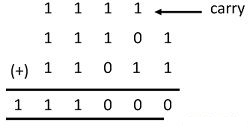Difference between revisions of "Addition"
(→Binary Addition) |
(→Adding Binary Numbers Into Denary) |
||
| Line 46: | Line 46: | ||
==Adding Binary Numbers Into Denary== | ==Adding Binary Numbers Into Denary== | ||
| + | |||
| + | There are many ways to add two binary numbers together and get a denary value as the answer. The two main ways of doing are as follows: Method 1, Calculate the denary value of each binary number then add them together, then you have the answer. Or Method 2 which is just as simple. Add the two binary numbers together using 8-bit binary addition, then convert your binary answer into denary. | ||
=Revision= | =Revision= | ||
Revision as of 12:34, 15 November 2017
Contents
[hide]Binary Addition
Binary is being able to add two numbers together but are represented in binary form, which consist of 1s and 0s
There are four possibilities when adding binary numbers, these possibilities are:
a total of 0 (0+0) put down 0 a total of 1 (1+0, 0+1 or 0+0+carried 1) put down 1 a total of 2 (1+1) put down 0, carry 1 a total of 3 (1+1+ carried 1) put down 1, carry 1
For example, solve 6+7 using binary addition:
First convert 6 and 7 from denary to binary using your preferred method
6 = 4+2+0 = 110 7 = 4+2+1 = 111
Then add them keeping in mind the 4 possibilities and add each digit together, starting on the right:
110 + 111
So:
0+1 = 1
1+1 = 0 carry 1
1+1+ carried 1 = 1 carry 1
1 + 0 = 1
so 110+111 = 1101. Converting this number back to denary gives us an answer of 13.
Another Example
Adding More Numbers Together
You could get 3 numbers to add however you wont be given a situation in which there are more than a total of 3.
For example:
101
101
011+
Which would = 1101
Adding Binary Numbers Into Denary
There are many ways to add two binary numbers together and get a denary value as the answer. The two main ways of doing are as follows: Method 1, Calculate the denary value of each binary number then add them together, then you have the answer. Or Method 2 which is just as simple. Add the two binary numbers together using 8-bit binary addition, then convert your binary answer into denary.
